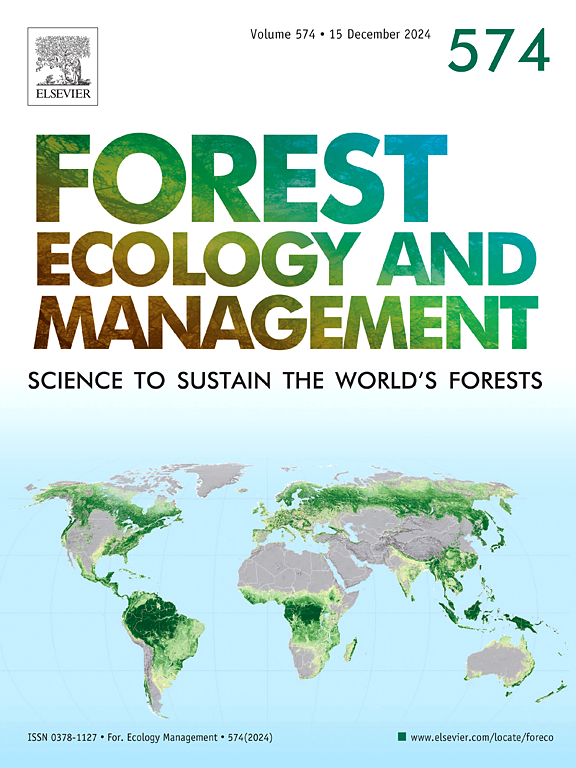两种寄主植物白桦(桦科)和西伯利亚落叶松(松科)组成化学防御化合物的纬向变化
IF 3.7
2区 农林科学
Q1 FORESTRY
引用次数: 0
摘要
地球气候的动态变化导致交错带向北移动。植食性昆虫通常在它们的寄主植物种群之前扩张。由于这种范围的扩大,植食昆虫将面临新的寄主植物种群/物种,这些寄主植物可能具有不同的组成化学防御化合物,影响昆虫的生长和发育。本文研究了全北极地区最广泛的森林入侵害虫之一异Lymantria dispar在不同寄主植物种群中潜在毒性决定因素的分布。本文以西伯利亚西部的白桦(Betula pendula)和西伯利亚落叶松(Larix sibirica)为研究对象,采用了覆盖白桦历史地理范围和近期自然分布的1000公里南北样带。我们分析了西伯利亚松针中的脂肪酸、二萜、β-谷甾醇、醇-壬花椰菜-10-醇和壬花椰菜-10-on。我们还分析了同一物候阶段的三萜类化合物,认为这些化合物可能是害虫自下而上扩张的调节剂。结果表明,西伯利亚松林春季针叶中脱氢枞酸和壬烷酸-10-醇的浓度从南向北呈显著下降趋势。此外,我们观察到沿相同的南向北梯度,这些针叶中的脂肪酸水平显著增加。春叶中三萜类化合物沿纬度梯度呈非线性分布。目前还没有对西伯利亚白桦次生代谢物(即对食草昆虫的化学防御)的变异进行研究,尽管已知化学变异具有时间依赖性,但对白桦叶片发育的物候阶段的研究并未包括在内。我们目前的研究填补了这些空白。研究结果表明,西伯利亚白杨中的脱氢枞酸和壬二酸-10-醇可能会促进森林落叶类植物L. dispar的向北扩张,而B. pendula中的三萜似乎不太可能阻碍这种范围的转移。本文章由计算机程序翻译,如有差异,请以英文原文为准。
Latitudinal variation in constitutive chemical defense compounds in two host plants of Lymantria dispar (Lymantriidae): Betula pendula (Betulaceae) and Larix sibirica (Pinaceae)
Dynamics of changes in Earth's climate cause movement of ecotones in the northern direction. Phytophagous insects often expand ahead of populations of their host plants. Due to this range expansion, phytophagous insects will face new populations/species of host plants, which may differ in constitutive chemical defense compounds affecting the insects' growth and development. In this paper, we studied the distribution of potential determinants of toxicity among different populations of host plants of Lymantria dispar: one of the most widespread invasive forest pests in the Holarctic region. We focused on Betula pendula and Larix sibirica populations in Western Siberia, using a 1000-km-long north–south transect covering both L. dispar's historical geographic range and recent natural distribution. We analyzed fatty acids, diterpenoids, β-sitosterol, alcohol nonacosan-10-ol, and nonacosan-10-on in L. sibirica spring needles. We also assayed triterpenoids in B. pendula spring leaves at the same phenological stage, considering these compounds potential bottom-up regulators of pest expansion. We found a significant decrease in concentrations of dehydroabietic acid and nonacosan-10-ol (antifeedant compounds for L. dispar), from south to north in spring needles of L. sibirica. Additionally, we observed a significant increase of fatty-acid levels in these needles along the same south-to-north gradient. There was a nonlinear pattern of the distribution of triterpenoids along the latitudinal gradient in the spring leaves of B. pendula populations. Studies on the variation of plant secondary metabolites — chemical defenses against herbivorous insects — have not been conducted for L. sibirica, and existing research on B. pendula did not include information on the phenological stages of leaf development, despite the known temporal dependence of chemical variability. Our current study fills these gaps. Our findings reveal that dehydroabietic acid and nonacosan-10-ol in L. sibirica may facilitate the northern expansion of the forest defoliator L. dispar and triterpenoids in B. pendula appear unlikely to impede this range shift.
求助全文
通过发布文献求助,成功后即可免费获取论文全文。
去求助
来源期刊

Forest Ecology and Management
农林科学-林学
CiteScore
7.50
自引率
10.80%
发文量
665
审稿时长
39 days
期刊介绍:
Forest Ecology and Management publishes scientific articles linking forest ecology with forest management, focusing on the application of biological, ecological and social knowledge to the management and conservation of plantations and natural forests. The scope of the journal includes all forest ecosystems of the world.
A peer-review process ensures the quality and international interest of the manuscripts accepted for publication. The journal encourages communication between scientists in disparate fields who share a common interest in ecology and forest management, bridging the gap between research workers and forest managers.
We encourage submission of papers that will have the strongest interest and value to the Journal''s international readership. Some key features of papers with strong interest include:
1. Clear connections between the ecology and management of forests;
2. Novel ideas or approaches to important challenges in forest ecology and management;
3. Studies that address a population of interest beyond the scale of single research sites, Three key points in the design of forest experiments, Forest Ecology and Management 255 (2008) 2022-2023);
4. Review Articles on timely, important topics. Authors are welcome to contact one of the editors to discuss the suitability of a potential review manuscript.
The Journal encourages proposals for special issues examining important areas of forest ecology and management. Potential guest editors should contact any of the Editors to begin discussions about topics, potential papers, and other details.
 求助内容:
求助内容: 应助结果提醒方式:
应助结果提醒方式:


